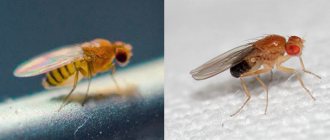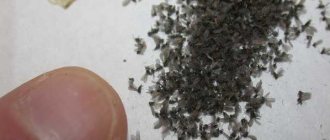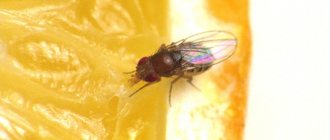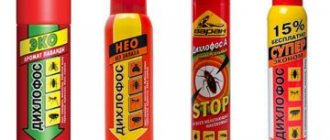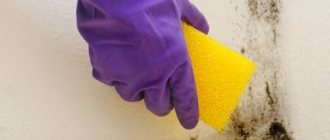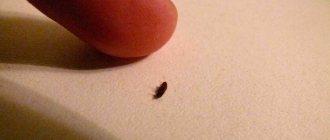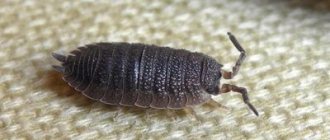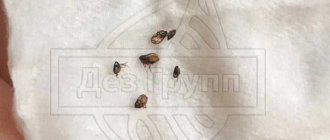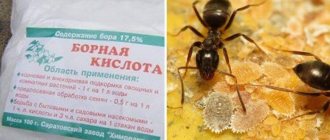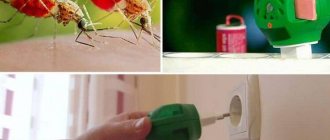Midges in the house are always a surprise. The appearance of one or two individuals goes unnoticed, but the insects multiply very quickly, and household members suddenly discover a cloud of annoying, chaotically moving midges in the kitchen or room.
You need to start fighting unwanted guests right away, because every day their number will grow, which means it will be more and more difficult to get rid of them.
Why do midges appear in the house?
Unfavorable factors that lead to the spread of midges in an apartment include:
- improper care of indoor plants or planting them in contaminated soil;
- entry from the street through open windows or entrance doors;
- rotting food;
- presence of garbage in the kitchen;
- leftover food from pets, occasional cleaning of cages and aquariums;
- insect eggs enter the house along with purchased fruit products, and in the warmth they begin to develop further;
- flies move freely from neighbors through ventilation ducts.
Immediately after detecting several midges in a room, measures should be taken immediately to destroy them. The number of midges is growing rapidly, so it will become more difficult to fight them every day.
Preventive actions
There are several simple rules that, if followed, will significantly reduce the risk of midges infesting your home:
- take out the trash daily;
- clear the table and wash dishes immediately after eating;
- Store fruits, berries and vegetables in the refrigerator, and regularly sort through those vegetables that should be stored at room temperature and throw away spoiled ones;
- Wash pets’ bowls daily and ensure that food does not sit too long;
- Water your house plants moderately, and do not allow water to stagnate in the trays;
- regularly change the bedding of pets (hamsters, rabbits, rats, etc.) so that less food residue accumulates in them;
- keep sinks and sinks clean, ensure that the drain does not become clogged;
- Wring out the dishwashing sponges thoroughly and replace them regularly with new ones.
The main thing is to monitor cleanliness, prevent moisture accumulation, and store food correctly. If you follow these recommendations, then midges that accidentally get into the house will not multiply and will disappear very soon.
How to determine the source of reproduction
Before you start expelling unwanted neighbors, you should determine where they come from:
- Initially, you need to check all the kitchen cabinets, open all the jars where food and cereals are stored.
- You should carefully examine the filters that are located in the sinks.
- Wet kitchen rags attract the attention of insects.
- It is necessary to wash the bathtub, washbasin, and sink using cleaning products.
- Often the appearance of midges is associated with potted flowers, so they should not be ignored.
- Every corner of all rooms should be checked.
- If fruits or vegetables are stored in boxes at home, they need to be checked for rotting.
Half the battle is done if a midge habitat is found. After this, all that remains is to choose a means for their complete destruction.
Varieties
There are many varieties of flies. All of them are dipterous, characterized by small sizes (no more than 6 mm). The difference lies in the food necessary for their life, habitat and speed of spread.
Drosophila
Drosophila is a small food midge. You can notice them in the kitchen, where rotten food or fermented drinks lie. You can also bring in unwanted guests along with purchased fruits or vegetables. The length of their small body is approximately 3 mm. The color of insects is black or yellow-brown. The female lays up to 700 eggs throughout her life. The insect grows quickly, within 9 days.
Whiteflies
A pest such as whitefly may appear on indoor plants. A small insect, no more than 3 mm in size, distinguished by its white color. The larvae of the individuals feed on plant sap, and in a short time the flower dies.
Whiteflies enter the house through open windows and vents or along with contaminated soil. Before starting treatment, it is necessary to isolate the infected flower from other plants.
See also
17 best remedies for fungus and mold on walls with descriptions
Flower midges
There are many varieties of house flies. The most common unwanted guests are white midges (springtails). There is a high probability of the appearance of black midges (sciarids).
There are several reasons for the appearance of flower midges:
- waterlogging of the soil;
- open windows and entrance doors;
- fertilizing the soil with folk compounds;
- contaminated soil.
The most effective way to kill insects in flowers is to replace the soil. Drugs such as Aktara, Bazudin, Fitoverm, and Thunder can come to the rescue.
Butterflies
The butterfly is a small winged insect with a fluffy gray-brown body. The reason for the appearance of midges in the house is poor ventilation, damp, cool air, lack of light, and failure to maintain cleanliness in the room.
This insect does not bite, does not spread infections, and does not damage furniture or food. Large concentrations of butterflies can provoke allergic reactions, especially in children.
The main method of combating this type of midge is to eliminate humidity in the room. If the room is cold, then you need to install additional heating and ventilation devices. Surfaces should be disinfected. Be sure to seal all the cracks and cracks in the walls and floors.
How to fight
The most difficult thing is to find the source of the spread of midges. Usually, the inhabitants of the apartment do not pay attention to one or two individuals hovering in the air in front of their faces. The battle begins after there are too many insects. The first step is to determine what species we are dealing with. Based on this, we independently choose ways to effectively combat midges in the house. If fruit flies are detected, it is recommended to review and sort vegetable supplies, throw away those affected by foulbrood, and change their storage conditions.
If moisture-loving insects have settled in a flower pot or on seedlings that are overly flooded with water, it means that the soil is contaminated with pathogenic microflora. The only way out is to transplant the flower. Reducing the volume of watering and refusing to fertilize with tea leaves will also eliminate the spread of midges.
When fungus gnats are identified, the problem is solved using surface drainage. Quick-drying gravel, sand or expanded clay sprinkled on top of the ground will prevent midges from laying eggs. In the near future you will be able to completely get rid of small insects.
How to determine whether a midge is fruit or another
The accumulation of fruit midges is observed on sweet berries, fruits and drinks. They can be distinguished by the following criteria:
- very small sizes (from 1 to 3 mm);
- the body is oblong with two wings and six legs;
- flight is slow;
- the color is brownish-yellow, less often black or orange.
Fruit flies lay eggs on the surface of sweet fruits. As soon as they begin to deteriorate, the larvae begin to develop further. They are not dangerous for the human body, but the very fact of their presence is unpleasant.
Types of midges
House midges are not just one type of insect, but many varieties of tiny uninvited guests, each of which has its own tastes and preferences. The family of dipterous midges includes approximately 2 thousand species. Once you know the type of insect, it is easier to choose an effective method to eliminate the problem.
- The most common and insidious species are fruit flies. They are also called fruit, wine or fruit. Outwardly, they resemble ordinary flies in a reduced format - 1-3 mm. The most common insects are black, brown, and orange in color. The names indicate their feeding system: they are attracted by the smell of spoiled fruits, vegetables, fruits, fermented juices and strong drinks.
In addition, they love sweets very much, but will not refuse to mark themselves in the trash can or kitchen sink, and at the same time lay their eggs everywhere.
- One of the most harmful insects is sciarids (fungus gnats) that live in flower pots. Small midges up to 3 mm in size appear when there is excessive soil moisture. They are not dangerous to humans, but plants suffer due to the fact that the larvae take away their nutrients.
- Humpback midges (sewer midges), abundantly covered with hairs, live in damp, gloomy rooms with faulty sewers, in untidy kitchens, and crawl out of clogged bathroom sinks. Their harm lies in the fact that they carry pathogenic bacteria.
- Whiteflies are easy to distinguish from other midges - their bodies, up to 3 mm long, are usually covered with whitish pollen. Most often found in poorly ventilated areas with indoor flowers growing in waterlogged soil. They are indicated by a white coating on the shoots and scaly larvae on the underside of the leaves. Orchids often suffer from them. Midges start from dampness, feed on the sap of plants and destroy them.
Other types of midges are found indoors:
- clothes that live in closets;
- aquatic, inhabiting places with high humidity;
- a vile whose bites are extremely painful.
Many species of midges prefer to settle in damp basements filled with mold and rotten air in abandoned dachas. They usually easily penetrate apartments on the first floors.
Are insects dangerous?
Many types of insects are dangerous because they become carriers of various diseases:
- They carry pathogenic microbes on their paws.
- Swelling and inflammation may appear at the site of midge bites.
- People prone to allergies develop unpleasant symptoms, including anaphylactic shock.
Therefore, if insects are found, it is so important to understand the reason for their appearance and find the most effective ways to get rid of them.
What are the most effective mosquito repellents?
Compositions against midges can be of chemical origin or have a natural base:
- Chemical preparations include: “Raid”, “Combat”, “Dichlorvos”, “Aktaru”, “Bazudin”. These products are used with extreme care. First, all things are removed from the room, windows and doors are closed.
- Traditional recipes based on vinegar, potassium permanganate, laundry soap, and essential oils are considered effective.
- All kinds of traps are popular.
- Smoking with camphor helps.
- If the source of insects is found, a vacuum cleaner will help. After turning on, the vacuum cleaner is directed towards the accumulation of midges. Afterwards you need to shake the bag.
- Insects cannot tolerate certain strong odors, such as orange or clove. Therefore, it is recommended to place these components throughout the apartment.
The main condition for fighting insects is maintaining cleanliness in all corners of the house.
Features of the fight against midges in the bathroom and basement of the house
The bathroom attracts midges from all over the apartment. This is quite simple to explain - small flies prefer rooms with high humidity, which means the bathroom is most suitable for them. Drains and sewer pipes are the habitat of butterflies (sewer midges). It is always warm here, so insects are comfortable not only in summer, but also in winter.
To quickly get rid of midges, you need to try to reduce the level of humidity in the bathroom. Fix leaking taps, ventilate after showering, don’t hoard dirty laundry. Be sure to use pipe cleaners from time to time.
Fragrant herbs and solutions
Scented ingredients will help get rid of annoying insects. Folk recipes often contain herbs and essential oils, the smell of which repels midges.
List of things insects are afraid of:
- essential oils obtained from cloves, eucalyptus, thyme, valerian, lavender, cedar;
- Among the plants, mint, basil, geranium, and juniper can be distinguished.
Since odors disappear quickly, they need to be renewed every 2.5 hours. In addition, it must be taken into account that high concentrations of these substances in the air lead to headaches and allergic reactions.
Camphor
Camphor solution is harmless to humans, but its smell destroys midges. A small amount of camphor is heated in a frying pan, and then carried through all the rooms. In the near future there will not be a single fly.
See also
Description of the Fly Lady home cleaning system and features for workers
Carnation
The smell of cloves cannot be tolerated by flies, so it is often included in folk recipes:
- 200 ml of water is poured into the container.
- Add 5 g of dried, crushed cloves.
- Then the container is placed on the fire and left for two hours.
While the clove is boiling, it emits an unpleasant aroma for insects, and they quickly leave the room.
Oil burner
Aroma lamps are considered easy to use. When heated, the aromatic oils that are poured into the bowl begin to fill the room with a pungent odor. The aromas of basil, anise, and eucalyptus oils are unpleasant for insects.
Homemade traps
In order to catch insects flying around the house, you can make traps with your own hands.
Jar with bait
The spoiled fruit is placed in a jar and covered with gauze or cling film with several holes. Insects will be able to freely enter the container, but will not be able to fly back. Then pour boiling water into the jar and pour it out.
There is another proven bait option. A product is placed in a glass jar. Make a funnel out of paper, the base of which will correspond to the diameter of the container. Then a funnel is placed inside the jar, neck down, without touching the bottom.
Beer bottle
An unwashed, open beer can must be left in the room. After some time, you can find a cluster of winged insects at the bottom of the bottle.
Duct tape
Sticky tape is considered popular and is used to catch annoying insects. The sticky layer consists of a substance whose smell attracts midges. When they land on the surface of the tape, they stick and die.
Poisonous sheets of paper
This option involves hanging sheets of paper soaked in a special solution in various places in the apartment. It is easy to prepare the solution. It is enough to add 40 g of sugar and 60 g of ground pepper to 230 ml of milk.
Lures
You can kill insects using bait. There are many options for making baits for annoying midges.
Formaldehyde recipe
A solution based on formaldehyde, milk and water helps kill unwanted guests. 30 ml of formalin, 90 ml of milk and 150 ml of water are poured into the container. The resulting mixture attracts insects with its smell, but upon contact with the solution they immediately die.
Recipe with detergent
A drink (juice, compote, wine) is poured into a plate, which attracts insects. Add a few drops of liquid cleaning product to the selected drink. As a result, the midges will not be able to linger on the surface of the drink and will drown.
Folk remedies
Many housewives, when choosing how to remove small midges from an apartment, do not want to use chemicals or mechanical methods to combat insect invasion, preferring safe folk recipes that are easy to implement in a private home. They are based on the use of repellent aromas and the construction of special traps for insects. The purpose of a simple homemade device is to lure midges into a trap and block its exit from there.
Disposable cup
Bait is placed at the bottom of the container: rotten fruits, sour juices, compotes. Apple cider vinegar works best. A film with a tiny hole through which midges penetrate is fixed to the upper edges of the glass. She won't get back. All that remains is to pack the glass more tightly and remove it from the house.
Glass jar
The mechanism of action of the trap is the same as with a glass. A bait that has the smell of fermentation (beer, kvass, homemade wine is suitable) is placed inside a small container (0.5 - 1 l). The vessel is covered with a paper funnel taped to the neck with a tiny hole at the narrow end. Once in the jar, attracted by the seductive smell of beer, the midges will no longer be able to escape. It won’t be difficult to get rid of them by taking them outside.
Duct tape
Fly stickies produced by manufacturers are a ready-made option suitable for killing midges. They are unrolled and hung from the ceiling in the kitchen, where harmful insects are spotted. Impregnated with a special adhesive solution, they attract flies with a characteristic odor and destroy them.
Detergents
A liquid mixture serving as bait is poured into the bottom of a 0.5-liter jar, transparent so that the result is clearly visible. No lid required. Cover the top of the solution with a small amount of dishwashing detergent. A light film forms on the surface, which will not allow insects to escape from the trap and will kill them.
Milk and black pepper
This effective shallow dish trap can even be placed on a table or windowsill. A mixture of 200 ml milk, 4 tbsp. l. ground pepper and 8 tbsp. l. Boil sugar over low heat for 10 minutes and pour it into a saucer, and also moisten paper sheets with it, which are laid out in problem areas.
Formalin
An effective means of combating small insects is a mixture of formaldehyde with water and milk in a ratio of 1:5:3. The solution is used in the same way as the previous recipe.
Special store products
There are various midge repellents on store shelves. Most formulations are safe for the health of all family members, including pets.
List of well-known and fast-acting remedies:
- Drugs such as “Combat”, “Dichlorvos”, “Doctor Klaus” are produced in the form of aerosols. It is enough to spray the product in the room. Pre-close the windows, put away food, clothes, and toys. After spraying, the windows must be opened to allow any remaining chemical components to evaporate.
- Fumigators (Raid, Window fly trap) are considered less safe. A plate or container with liquid is inserted into a special case, which, after heating, begins to emit insecticide. The action comes on slowly.
- Light traps are used to kill flies. Insects die from exposure to current. Appliances consume a lot of energy and make noise.
- You can hang repellents in the room where the midges have settled. The plates, which are inserted into a special case, repel insects. It is necessary to periodically ventilate the room so that harmful vapors of the drug do not accumulate.
Any purchased products should be used with caution. It is important to follow all the rules and recommendations specified in the instructions.
The nuances of insect control
The specifics of work to expel midges from an apartment will depend on the location of their accumulation.
In a private house
In a country house, midges appear for the same reasons as in a city home. You can poison insects either with purchased products or with compounds you prepare yourself.
See also
How to quickly and effectively get rid of mice and rats, 20 home remedies
Most private homes have a basement for storing food, which becomes an additional source of risk. Housewives should carefully monitor vegetables and fruits that are stored in the basement or cellar at the dacha. Food that begins to rot should be removed from storage immediately.
In the apartment
The following methods will help you deal with flies in your apartment:
- you need to arrange through ventilation, insects will disappear along with the air flow;
- you can go through the places where flies accumulate with a vacuum cleaner;
- Essential oils expel insects from the room (the smell of cloves or verbena is effective).
When using either option, special care should be taken if children and pets live in the home.
In bathroom
The bathroom also creates good living conditions for midges. To reduce the risk of their appearance in this place, you need to periodically clean the sewer pipes. Ideally, they should be removed and cleaned. If this is not possible, then it is recommended to use products that prevent the formation of blockages.
You can make a remedy for the development of blockages yourself. Pour 100 g of baking soda into the drain hole, then pour in 90 ml of vinegar. After 17 minutes, 250 ml of water is poured into the drain hole. To enhance the cleansing effect, it is recommended to use a plunger.
In the kitchen
The kitchen is considered the most common habitat for midges, as there are all the conditions for their development. To speed up the process of getting rid of them, you should follow these rules:
- after eating you need to wipe the table, sweep the floor and immediately wash the dishes;
- food and drinks must not be left open;
- throw out trash on time;
- be sure to keep the sink clean;
- wet rags should be dried immediately on the radiator.
When some varieties of midges appear, the listed control measures will be sufficient. In other cases, additional use of drugs is required.
On the windows
If midges appear on windows, then indoor plants are the likely cause. Therefore, first of all, you will need to review the soil and establish a watering regime.
Geranium has a repellent effect. Therefore, you need to place a pot of geraniums on the window with insects. The spicy smell of tomatoes, which are also grown on the windowsill, also repels insects.
How to remove midges from flowers?
You can fight midges that have infested flowers in the following ways:
- change the soil, rinse the roots with running water, and pour boiling water over the new soil;
- A solution of potassium permanganate, which is used to water the plants every two days, helps;
- Watering and spraying with garlic infusion helps to expel insects;
- you can sprinkle the soil with ground pepper;
- orange peels emit an unpleasant aroma for midges, so thin slices of peel are distributed over the surface of the soil;
- match sulfur contributes to the death of insect larvae.
The main thing is to choose components that are safe for plants, otherwise they may die.
Effective ways to get rid of midges in an apartment
There are many ways to remove midges from an apartment. Most housewives prefer to use safe folk remedies, traps and natural repellents. If this does not help, more powerful chemicals are used.
Finding and eliminating the source of infection
The fight against midges begins with identifying the source of infestation. You need to carefully examine the room where the largest concentration of midges is observed, and try to understand what exactly attracts insects and where they are localized. Rotting fruit or a glass with the remains of wine, an apple core that has rolled under the cabinet, tea leaves that were used as fertilizer for indoor flowers, a tray with stagnant water - all this can be the reason that midges have appeared at home.
Often midges can be found in a kitchen cabinet or on the ceiling.
To eliminate all factors that provoke the spread of insects, you need to carry out thorough cleaning, paying attention to the most inaccessible places.
Duct tape
If there are a lot of midges in the house, sticky tape will help to significantly reduce their number. Considering that the product is absolutely non-toxic, it can be used to get rid of midges not only in rooms, but also in the kitchen or basement where food is stored.
Traps and bait
An effective remedy against house flies is traps. They can be purchased or homemade. The advantages of homemade structures are obvious - to make them, you will need very little time and materials that can be found in any home. Midge trap options:
- a plastic cup covered with cling film with holes made in it;
- a jar into which a paper cone is inserted, narrow end down;
- an unwashed bottle of sweet wine, liquor or beer;
- plastic bag.
Trap
As bait, you can use a slice of sweet fruit, fruit juice, jam, or apple cider vinegar diluted with water.
Repellents
Some odors help fight midges, which insects cannot stand and try to get away from them as soon as possible. The scent helps get rid of midges:
- essential oils (eucalyptus, lemon, lemongrass, patchouli, ylang-ylang);
- spices (cloves, vanilla, bay leaf);
- herbs (wormwood, yarrow, thyme, tansy).
Most insects cannot tolerate the aroma of incense.
Industrial insecticides
Insecticidal preparations are the most effective remedy against midges. The active substance acts on both adult insects and larvae. Insecticides are available in various forms:
- powders and granules;
- concentrates for preparing solutions;
- aerosols;
- fumigators.
Aerosols and fumigators are most often used. They are convenient to use, and the insecticide easily spreads throughout the room. Granular preparations and solutions are mainly used to kill midges on indoor plants.
Despite the fact that chemicals help get rid of midges in an apartment in a short time, not everyone is ready to use them, since insecticides are toxic and most of them have an unpleasant odor. An alternative is biological products containing natural ingredients.
Repellents
Products with a strong odor will help get rid of black flies, such as:
- turpentine;
- ammonia;
- camphor.
To drive away the midges sitting on the windows, it is enough to wipe the window sills and window frames (and possibly glass) with water with the addition of ammonia.
You can get rid of midges in your apartment quite simply by heating camphor in a dry frying pan and then walking through all the rooms with the frying pan. The specific smell is unbearable for insects, and they will quickly leave the room.
Helper plants
Indoor plants are a passive, but quite effective method of controlling midges at home. If there is a pot of geranium or lavender in the room, midges are unlikely to appear in this room.
Another rather unusual way is to have a carnivorous plant at home. For example, a Venus flytrap will become an exotic interior decoration, and at the same time kill a dozen or two midges that approach it.
Folk remedies
Folk remedies are most preferred by most housewives, since they are not dangerous to people and animals, which means they can be used to combat midges in any room. In addition to the essential oils, plants and spices already listed above, the following will help remove midges:
- “Star” balm - its smell will quickly drive away insects;
- horseradish - just spread fresh leaves on window sills, tables, work surfaces;
- orange peels;
- laundry soap (helps get rid of midges on indoor flowers).
Laundry soap
You can pour a little sweet syrup or jam diluted with water into the sink. When the midges flock to the treat, turn on the water and wash the pests down the drain. By the way, ordinary boiling water will help get rid of sewer midges, which should be slowly poured into the sink drain.
